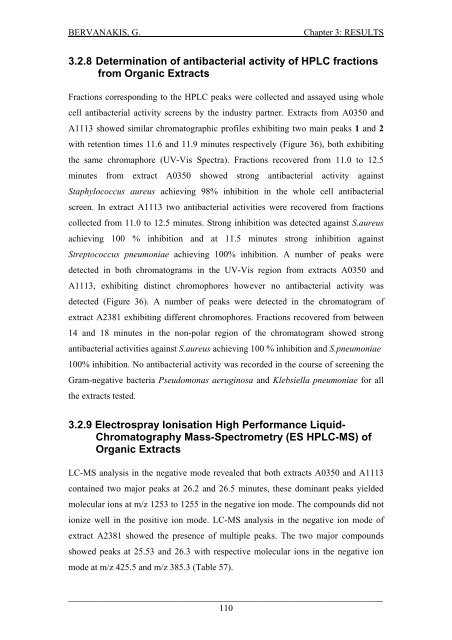Detection and Expression of Biosynthetic Genes in Actinobacteria ...
Detection and Expression of Biosynthetic Genes in Actinobacteria ...
Detection and Expression of Biosynthetic Genes in Actinobacteria ...
Create successful ePaper yourself
Turn your PDF publications into a flip-book with our unique Google optimized e-Paper software.
BERVANAKIS, G.Chapter 3: RESULTS3.2.8 Determ<strong>in</strong>ation <strong>of</strong> antibacterial activity <strong>of</strong> HPLC fractionsfrom Organic ExtractsFractions correspond<strong>in</strong>g to the HPLC peaks were collected <strong>and</strong> assayed us<strong>in</strong>g wholecell antibacterial activity screens by the <strong>in</strong>dustry partner. Extracts from A0350 <strong>and</strong>A1113 showed similar chromatographic pr<strong>of</strong>iles exhibit<strong>in</strong>g two ma<strong>in</strong> peaks 1 <strong>and</strong> 2with retention times 11.6 <strong>and</strong> 11.9 m<strong>in</strong>utes respectively (Figure 36), both exhibit<strong>in</strong>gthe same chromaphore (UV-Vis Spectra). Fractions recovered from 11.0 to 12.5m<strong>in</strong>utes from extract A0350 showed strong antibacterial activity aga<strong>in</strong>stStaphylococcus aureus achiev<strong>in</strong>g 98% <strong>in</strong>hibition <strong>in</strong> the whole cell antibacterialscreen. In extract A1113 two antibacterial activities were recovered from fractionscollected from 11.0 to 12.5 m<strong>in</strong>utes. Strong <strong>in</strong>hibition was detected aga<strong>in</strong>st S.aureusachiev<strong>in</strong>g 100 % <strong>in</strong>hibition <strong>and</strong> at 11.5 m<strong>in</strong>utes strong <strong>in</strong>hibition aga<strong>in</strong>stStreptococcus pneumoniae achiev<strong>in</strong>g 100% <strong>in</strong>hibition. A number <strong>of</strong> peaks weredetected <strong>in</strong> both chromatograms <strong>in</strong> the UV-Vis region from extracts A0350 <strong>and</strong>A1113, exhibit<strong>in</strong>g dist<strong>in</strong>ct chromophores however no antibacterial activity wasdetected (Figure 36). A number <strong>of</strong> peaks were detected <strong>in</strong> the chromatogram <strong>of</strong>extract A2381 exhibit<strong>in</strong>g different chromophores. Fractions recovered from between14 <strong>and</strong> 18 m<strong>in</strong>utes <strong>in</strong> the non-polar region <strong>of</strong> the chromatogram showed strongantibacterial activities aga<strong>in</strong>st S.aureus achiev<strong>in</strong>g 100 % <strong>in</strong>hibition <strong>and</strong> S.pneumoniae100% <strong>in</strong>hibition. No antibacterial activity was recorded <strong>in</strong> the course <strong>of</strong> screen<strong>in</strong>g theGram-negative bacteria Pseudomonas aerug<strong>in</strong>osa <strong>and</strong> Klebsiella pneumoniae for allthe extracts tested.3.2.9 Electrospray Ionisation High Performance Liquid-Chromatography Mass-Spectrometry (ES HPLC-MS) <strong>of</strong>Organic ExtractsLC-MS analysis <strong>in</strong> the negative mode revealed that both extracts A0350 <strong>and</strong> A1113conta<strong>in</strong>ed two major peaks at 26.2 <strong>and</strong> 26.5 m<strong>in</strong>utes, these dom<strong>in</strong>ant peaks yieldedmolecular ions at m/z 1253 to 1255 <strong>in</strong> the negative ion mode. The compounds did notionize well <strong>in</strong> the positive ion mode. LC-MS analysis <strong>in</strong> the negative ion mode <strong>of</strong>extract A2381 showed the presence <strong>of</strong> multiple peaks. The two major compoundsshowed peaks at 25.53 <strong>and</strong> 26.3 with respective molecular ions <strong>in</strong> the negative ionmode at m/z 425.5 <strong>and</strong> m/z 385.3 (Table 57)._____________________________________________________________________110















